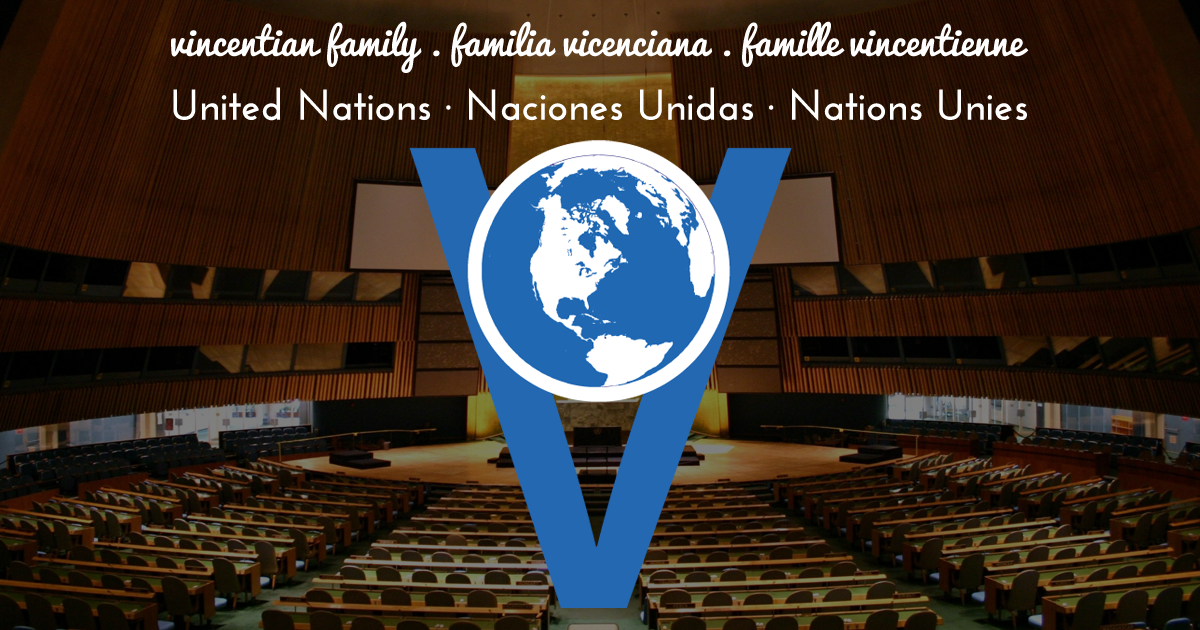UN Joins In Making Girls Count
Girls were among persons “left behind” by society in the time of St. Louise de Marillac. According to “Louise de  Marillac: a Committed Woman,” [1] Louise took interest in educating poor country girls while others were unconcerned. Richelieu stated (in his last testament) that such education was useless and even dangerous because it might divert them from their domestic responsibilities.
Marillac: a Committed Woman,” [1] Louise took interest in educating poor country girls while others were unconcerned. Richelieu stated (in his last testament) that such education was useless and even dangerous because it might divert them from their domestic responsibilities.
Louise wanted girls to have a solid foundation for life. She instructed girls when visiting Confraternities. She would then seek a woman able to continue educating them. After founding the Daughters of Charity, she encouraged sisters to become literate and arranged the formation of some as teachers so that they could instruct the girls.
Like Louise, the United Nations recognizes the value of nurturing girls to reach their full potential. UN Resolution 66/170 states: “Empowerment of and investment in girls are key in breaking the cycle of discrimination and violence and in promoting and protecting the full and effective enjoyment of their human rights.”
UPCOMING INTERNATIONAL DAYS
October 6: UN celebration of International Day of Older Persons (which falls on the weekend, October 1)
October 9: World Post Day
October 10: World Mental Health Day
October 11: International Day of the Girl
October 13: International Day for Disaster Reduction
October 16: World Food Day
October 17: International Day for the Eradication of Poverty
INTERNATIONAL DAY OF THE GIRL FOCUSES ON DATA
In keeping with Resolution 66/170, the UN on October 11 will honor the fifth annual International Day of the Girl. The theme for this year’s event is Girls’ Progress = Goals’ Progress: A Global Girl Data Movement. According to UNICEF, collecting and analyzing girl-focused data enables decision makers to measure and understand opportunities and challenges girls face. Data also influences policy and program decisions.
During Girls Speak Out, scheduled for the afternoon of October 11, girls will inform UN officials and governmental leaders about the amazing work they’re doing globally to promote human rights. An 11 Days of Action Campaign runs from October 1 to October 11. The Campaign addresses progress since the International Day of the Girl was first honored, and highlights goals for girls’ human rights globally. Each day of the campaign focuses on a different topic with a targeted Twitter chat. The days are sponsored by various organizations to promote social change and increase participation.
GIRLS AND THE SUSTAINABLE DEVELOPMENT GOALS
Today, October 6 also marks the launch of the IDG16 Brochure, which will include global statistics (and gaps in  gender data) on girls’ issues addressed in the Sustainable Development Goals (SDGs). SDG Goal 5 is to: Achieve gender equality and empower all women and girls. According to the UN, gender equality is not only a fundamental human right, but a necessary foundation for a peaceful, prosperous and sustainable world.
gender data) on girls’ issues addressed in the Sustainable Development Goals (SDGs). SDG Goal 5 is to: Achieve gender equality and empower all women and girls. According to the UN, gender equality is not only a fundamental human right, but a necessary foundation for a peaceful, prosperous and sustainable world.
Key components of SDG 5 which relate to girls are:
- 5.1–End all forms of discrimination against all girls (and women)
- 5.2—Eliminate violence against girls (and women), including trafficking, sexual, and other forms of exploitation
- 5.3—Eliminate harmful practices, such as child, early, and forced marriage, and female genital mutilation
- 5.c—Provide sound policies and enforceable legislation for the promotion of gender equality and the empowerment of all girls (and women) at all levels
PROGRESS
We’ve come a long way since Louise de Marillac advocated for girls. Examples of progress can be found in Southern Asia, where, according to the UN, only 74 girls were enrolled in primary school for every 100 boys in 1990. By 2012, the enrolment ratios were the same for girls as for boys. About two thirds of countries in the developing regions have achieved gender parity in primary education.
But many girls still remain significantly disadvantaged, face discrimination, deprivation, and are subject to violence.
STATISTICS
GIRLS AND EDUCATION
According to the World Bank, an estimated 62 million girls between the ages of 6 and 15 are not in school, and girls lag behind boys in completing secondary school. Sixteen million girls between the ages six and 11 will never start school, compared to eight million boys. A World Bank study found that every year of secondary school education is correlated with an 18 percent increase in a girl’s future earning power. Research shows that educating girls has a multiplier effect: better educated women tend to be healthier, participate more in the formal labor market, earn more income, marry at a later age, and provide better health care and education to their children. (Reaching Girls, Transforming Lives; World Bank Group Education Global Practice: Smarter Education Systems for Brighter Futures 2016 http://documents.worldbank.org/curated/en/212341467999691082/pdf/98450-REVISED-PUBLIC-WB-EGP-Reaching-Girls-040816-final6-web.pdf)
At the primary level, 23 percent of low-income countries (LICs) have achieved gender parity. At the secondary level, only 15 percent of LICs have achieved gender parity. The two developing regions with the most number of adolescent girls out of school are South Asia and Sub-Saharan Africa. In South Asia, 12.6 million girls of lower secondary school age were out of school in 2012; in Sub-Saharan Africa, this number was 11.8 million.
GIRLS AND POVERTY
Statistics related to girls and poverty are very difficult to find. But a 2013 article by The Guardian reflects that 250 million girls lived in poverty at that time. It points out that education is linked with escaping poverty. Each extra year of primary school increases a girl’s future wages by 10-20% and an extra year of secondary school by 15-25%. “Seventy per cent of a woman’s salary goes back into her family. If you want to tackle poverty, you help girls become women, get educated and employed,” says Thomas Reuters Foundation CEO Monique Villa. (Adolescent girls: the key to ending poverty?; Eliza Anyangwe; The Guardian; October 11, 2013).
GIRLS AND CHILD MARRIAGE
Over the period 2011-2020, more than 140 million girls will have become child brides, according to United Nations Population Fund (UNFPA). Many will drop out of school. The rates of child marriage are highest in sub-Saharan Africa, where around 4 in 10 girls marry before 18; about one in eight were married or in a union before age 15. In Latin America and the Caribbean and the Middle East and North Africa, 24 per cent and 18 per cent, respectively, of women between 20 and 24 were married in childhood.
One statistic reflects that every day more than 41,000 girls marry before the age of 18. Child marriage negatively affects the health and rights of adolescent girls and severely impedes global development and poverty eradication efforts. (http://www.costsofchildmarriage.org/)
GIRLS AND FORCED LABOR; HUMAN TRAFFICKING
The International Labour Organization estimates that women and girls represent the largest share of forced labor victims with 11.4 million trafficked victims (55%) compared to 9.5 million (45%) men. Women and girls make up 98% of victims of trafficking for sexual exploitation.
GIRLS AND FEMALE GENITAL MUTILATION
At least 200 million girls and women alive today living in 30 countries have undergone female genital mutilation.
OTHER VIOLENCE AGAINST GIRLS
Worldwide, an estimated one in three women will experience physical or sexual abuse in her lifetime. Almost one quarter of girls aged 15 to 19 worldwide (nearly70 million) report being victims of some form of physical violence since age 15. According to UNICEF, around 120 million girls under the age of 20 (about 1 in 10) have been subjected to forced sexual acts at some point in their lives.
UN Women point out that every 10 minutes, somewhere in the world, an adolescent girl dies as a result of violence. (http://www.unwomen.org/en/news/in-focus/girl-child#sthash.AKYwyA8h.dpuf)
DANGERS FACED BY GIRL REFUGEES AND MIGRANTS
Girls, like other vulnerable groups, face assaults, robbery, sexual violence, kidnapping, extortion, lack of basic necessities, and more as they flee conflict and economic challenges in many areas of the world. In fact, sometimes they are systematically targeted. And the number of women and girls migrating or fleeing is increasing. According to the Women’s Refugee Commission (WRC), as of January 15, 2016, just over 55% of those arriving in Europe are women and children, as compared to only 27% in June 2015.
The WRC, United Nations Population Fund (UNFPA) and NHCR recently assessed protection risks for women and girls on their journey to Greece and onwards in Europe, reports Human Rights Comment (July 3, 2016). They found that women and girls, especially those travelling alone, face particularly high risks of certain forms of violence, including sexual violence by smugglers, criminal groups and individuals in countries along the route. Another issue is lack of awareness on the part of the authorities and humanitarian actors of the occurrence of sexual and gender-based violence affecting this group. Also of concern were reports of sexual violence committed by guards in refugee centers. (Human Rights Comment, Commission for Human Rights, Council of Europe, July 3, 2016).
CREATIVE PROGRAMS TO CLOSE THE GENDER GAP
Creative world-wide efforts are demonstrating that the gender gap can be narrowed. According to the UN Girls Education Initiative (UNGEI), an initiative in Egypt provides food rations, such as rice and oil, to girls who attend 80 percent of school days receive food rations. The food assists with family needs. A math camp for girls in the Dominican Republic fueled girls’ dreams that they could become accountants and engineers, according to UN Women News. In June 2015, a Malawian chief annulled 330 customary marriages – of which 175 were girl wives and 155 were boy fathers, as a means of encouraging youth to return to school, and continue a healthy childhood.
Let’s follow in the footsteps of St. Louise and give girls a chance by promoting programs and policies which empower them.
[1] Louise de Marillac: a Committed Woman [This article appeared in Volume II of En tiempos de San Vicente de Paúl … y hoy, Editorial CEME, Santa Marta de Tormes (Salamanca) Spain, 1997, p. 257-272. The cited work was translated from the French by Martín Abaitua, CM (Au tempts de St. Vincent-de-Paul… et aujourd ‘hui), Animation Vicentienne, 16, Grande rue Saínt-Michel, Toulouse, France … this work is not attributed to any one author but it is stated in the Introduction that the articles were written by various authors].

Tags: United Nations







Great and informative Article. Thank you
Excellent article, Margaret. Thanks for your work!
Very important issue- Let’s hear it for girls all over the world. Thank you, Sr. Margaret, for bringing this info to our attention!
Thank you Margaret for sharing this information.